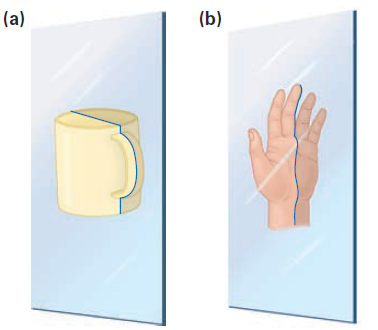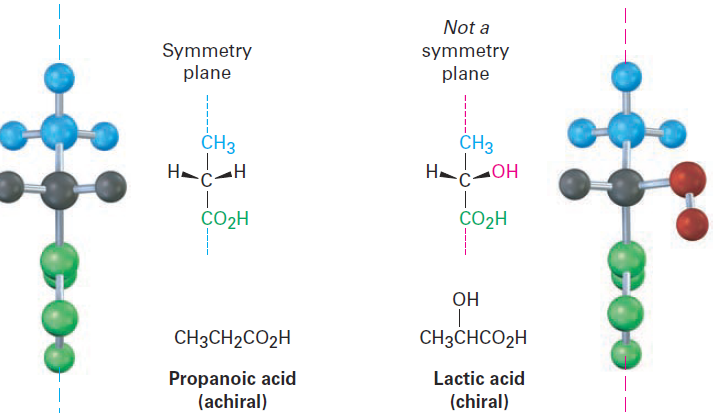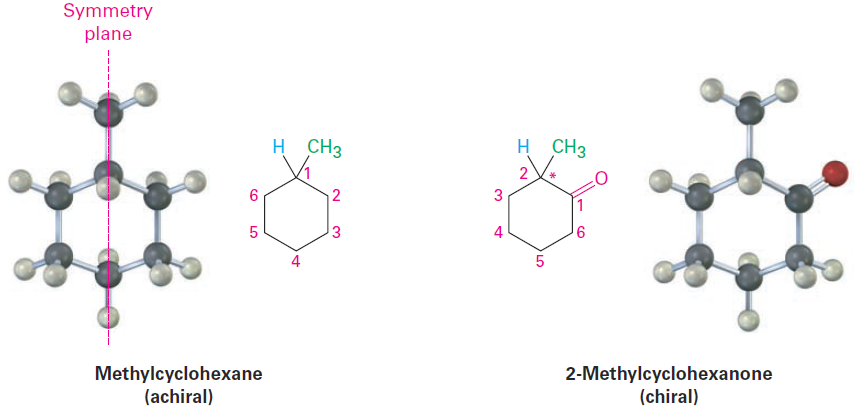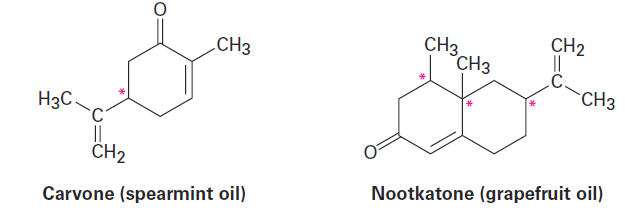
The Reason for Handedness in Molecules: Chirality
 المؤلف:
John McMurry
المؤلف:
John McMurry
 المصدر:
Organic Chemistry
المصدر:
Organic Chemistry
 الجزء والصفحة:
9th - p117
الجزء والصفحة:
9th - p117
 12-5-2016
12-5-2016
 29238
29238
The Reason for Handedness in Molecules: Chirality
A molecule that is not identical to its mirror image is said to be chiral (ky-ral, from the Greek cheir, meaning “hand”). You can’t take a chiral molecule and its enantiomer and place one on the other so that all atoms coincide. How can you predict whether a given molecule is or is not chiral? A molecule is not chiral if it has a plane of symmetry. A plane of symmetry is a plane that cuts through the middle of a molecule (or any object) in such a way that one half of the molecule or object is a mirror image of the other half. A coffee mug, for example, has a plane of symmetry. If you were to cut the coffee mug in half, one half would be a mirror image of the other half. A hand, however, does not have a plane of symmetry. One “half” of a hand is not a mirror image of the other half (Figure 1-1).

Figure 1-1 The meaning of symmetry plane. (a) An object like the coffee mug has a symmetry plane cutting through it so that right and left halves are mirror images. (b) An object like a hand has no symmetry plane; the right “half” of a hand is not a mirror image of the left half.
A molecule that has a plane of symmetry in any conformation must be identical to its mirror image and hence must be nonchiral, or achiral. Thus, propanoic acid, CH3CH2CO2H, has a plane of symmetry when lined up as shown in Figure 1-2 and is achiral, while lactic acid, CH3CH(OH)CO2H, has no plane of symmetry in any conformation and is chiral.

Figure 1-2 The achiral propanoic acid molecule versus the chiral lactic acid molecule. Propanoic acid has a plane of symmetry that makes one side of the molecule a mirror image of the other. Lactic acid has no such symmetry plane.
The most common, but not the only, cause of chirality in organic molecules is the presence of a tetrahedral carbon atom bonded to four different groups—for example, the central carbon atom in lactic acid. Such carbons are referred to as chirality centers, although other terms such as stereocenter, asymmetric center, and stereogenic center have also been used. Note that chirality is a property of the entire molecule, whereas a chirality center is the cause of chirality.
Detecting a chirality center in a complex molecule takes practice because it’s not always immediately apparent that four different groups are bonded to a given carbon. The differences don’t necessarily appear right next to the chirality center. For example, 5-bromodecane is a chiral molecule because four different groups are bonded to C5, the chirality center (marked with an asterisk). A butyl substituent is similar to a pentyl substituent, but it isn’t identical. The difference isn’t apparent until looking four carbon atoms away from the chirality center, but there’s still a difference.

As other possible examples, look at methylcyclohexane and 2 methylcyclohexanone. Methylcyclohexane is achiral because no carbon atom in the molecule is bonded to four different groups. You can immediately eliminate all - CH2 - carbons and the - CH3 carbon from consideration, but what about C1 on the ring? The C1 carbon atom is bonded to a - CH3 group, to an - H atom, and to C2 and C6 of the ring. Carbons 2 and 6 are equivalent, however, as are carbons 3 and 5. Thus, the C6–C5–C4 “substituent” is equivalent to the C2–C3–C4 substituent, and methylcyclohexane is achiral. Another way of reaching the same conclusion is to realize that methylcyclohexane has a symmetry plane, which passes through the methyl group and through C1 and C4 of the ring. The situation is different for 2-methylcyclohexanone. 2 Methylcyclohexanone has no symmetry plane and is chiral because its C2 is bonded to four different groups: a - CH3 group, an - H atom, a - COCH2 - ring bond (C1), and a - CH2CH2 - ring bond (C3).

Several more examples of chiral molecules are shown on the next page. Check for yourself that the labeled carbons are chirality centers. You might note that carbons in - CH2 - , - CH3, C=O, C=C, and C-C groups can’t be chirality centers. (Why not?)

 الاكثر قراءة في الهايدروكاربونات
الاكثر قراءة في الهايدروكاربونات
 اخر الاخبار
اخر الاخبار
اخبار العتبة العباسية المقدسة


